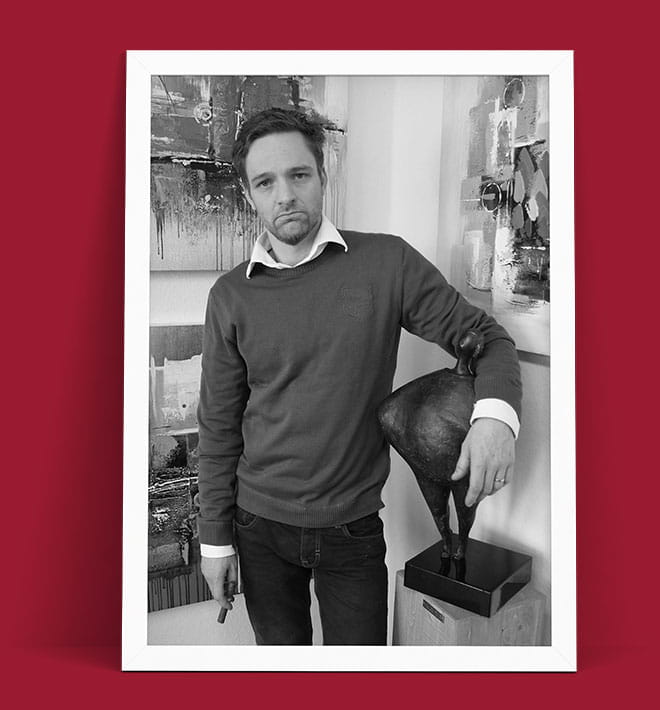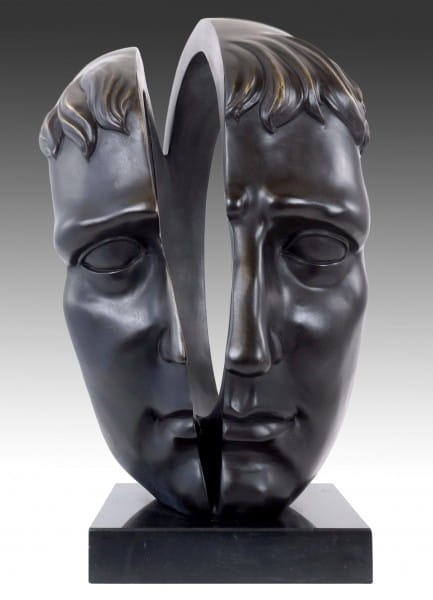€599.00 *
Prices incl. VAT, free shipping worldwide
Ready to ship today,
Delivery time appr. 3-6 workdays










Two Souls – A Contemporary Bronze Sculpture - Signed Martin Klein Born 1979, in the... more
Product description
"Face Art Mask - Two Souls - signed M. Klein"
| Weight | 9,3 kg |
Two Souls – A Contemporary Bronze Sculpture - Signed Martin Klein
Born 1979, in the tranquil town of Bischofswerda, Saxony, Martin Klein spent his earliest years captivated by the interplay of shadow and form among the Baroque facades of his hometown. As a boy, he would sketch the solemn faces of townspeople and study the way dusk lengthened their features, yearning to capture something of each person’s inner life on paper. His fascination with sculptural form took root as he observed masks displayed in local folk theaters—porcelain relics whose painted expressions seemed frozen between joy and sorrow. These childhood impressions, set against the region’s lush forests and winding riverbanks, nourished Klein’s eventual pursuit of fine art, guiding him to the Dresden Academy of Fine Arts and, later, to a vibrant atelier in Leipzig where he devoted himself to transforming raw clay into meditative bronze works.
Conceptual Genesis of “Two Souls”
Klein resolved to explore the duality inherent in every human heart—how two inner selves can coexist, sometimes in harmony and sometimes in conflict. He began by sketching interlaced faces on large sheets of tracing paper, searching for a composition that would suggest both unity and separation. In his Leipzig studio, he had shaped a clay model that fused two visages into a single form: one face emerges fully forward, eyes closed in serene introspection, while its counterpart, turned slightly to one side, bears a more restless gaze. Rather than simply merging these identities, Klein carved a narrow division between them—an intentional void that invites viewers to consider what unites and what divides us. The half-faces, reminiscent of a face art mask, evoke the theatrical masks of antiquity, suggesting that each of us wears many guises, revealing and concealing truths with every glance.
Craftsmanship and the Lost-Wax Ritual
Once the clay original met Klein’s exacting approval, he sent it to a revered foundry in the Ore Mountains, where artisans employed the time-honored lost-wax process. Molten bronze, shimmering at over 1,150 degrees Celsius, filled a ceramic shell that perfectly mirrored every subtle contour—from the furrowed brow of one countenance to the smooth, reflective curve of the other’s cheek. After cooling, the “Two Souls” form was chased carefully: seam lines were chased away, surfaces were refined, and fine details were sharpened. Klein then applied a deep, matte patina: charcoal-infused washes settled into the recessed areas, while gentle burnishing along the high points—temples, nose bridges, and lips—invoked the warm glow of flesh beneath skin. This patina serves not merely as finish but as a metaphor for the layers of experience that shape each inner self, lending the sculpture a living, almost breathing presence.
Symbolism of Harmonized Duality
“Two Souls” resonates as a meditative dialogue between introspection and outward awareness. The forward-facing visage, with its peacefully eyes, suggests a retreat inward—an acceptance of self beneath surface appearances. In contrast, the side profile’s stoic gaze and slightly parted lips hint at questions unspoken, emotions held in reserve. The thin division line between them is both literal and symbolic: a seam that binds them into a singular existence while marking the threshold between hidden thoughts and outward expression. Klein’s intent was not to depict conflict but to honor the complex interplay of conscious and subconscious selves, reminding us that true unity often emerges from respectful awareness of internal contrasts. In this respect, “Two Souls” embodies art with mask—offering viewers a moment to reflect on how masks reveal inner truths just as often as they conceal them.
Presence in Contemporary Spaces
Standing mounted on a sleek, black marble base, “Two Souls” commands a contemplative hush wherever it appears. In a minimalist living room with soft, neutral tones, the bronze’s charcoal patina draws the eye, inviting guests to linger and contemplate between its two faces. In a private office or study, positioned under a single narrow spotlight, the sculpture casts slender, elongated shadows that shift throughout the day—mirroring the shadow-play that animates human moods. Though rooted in classical portraiture traditions, the deliberate void of separation and the juxtaposed expressions lend “Two Souls” a distinctly modern sensibility. It transcends mere decoration, becoming a catalyst for introspection and dialogue about personal identity and the many masks we wear in daily life.
A Timeless Testament to Human Complexity
Signed discreetly “M. Klein” along the lower jaw of one face, this bronze work stands as a testament to its creator’s lifelong dedication to capturing the essence of human experience. As years pass, the patina will develop a gentle sheen, softening in places where light and touch encourage subtle luster. For collectors seeking a piece that bridges the contemplative gravity of classical sculpture with the probing questions of contemporary art, “Two Souls” offers a rich, multilayered experience. An enduring reminder that within each of us resides a harmony of souls, waiting to be recognized.
Born 1979, in the tranquil town of Bischofswerda, Saxony, Martin Klein spent his earliest years captivated by the interplay of shadow and form among the Baroque facades of his hometown. As a boy, he would sketch the solemn faces of townspeople and study the way dusk lengthened their features, yearning to capture something of each person’s inner life on paper. His fascination with sculptural form took root as he observed masks displayed in local folk theaters—porcelain relics whose painted expressions seemed frozen between joy and sorrow. These childhood impressions, set against the region’s lush forests and winding riverbanks, nourished Klein’s eventual pursuit of fine art, guiding him to the Dresden Academy of Fine Arts and, later, to a vibrant atelier in Leipzig where he devoted himself to transforming raw clay into meditative bronze works.
Conceptual Genesis of “Two Souls”
Klein resolved to explore the duality inherent in every human heart—how two inner selves can coexist, sometimes in harmony and sometimes in conflict. He began by sketching interlaced faces on large sheets of tracing paper, searching for a composition that would suggest both unity and separation. In his Leipzig studio, he had shaped a clay model that fused two visages into a single form: one face emerges fully forward, eyes closed in serene introspection, while its counterpart, turned slightly to one side, bears a more restless gaze. Rather than simply merging these identities, Klein carved a narrow division between them—an intentional void that invites viewers to consider what unites and what divides us. The half-faces, reminiscent of a face art mask, evoke the theatrical masks of antiquity, suggesting that each of us wears many guises, revealing and concealing truths with every glance.
Craftsmanship and the Lost-Wax Ritual
Once the clay original met Klein’s exacting approval, he sent it to a revered foundry in the Ore Mountains, where artisans employed the time-honored lost-wax process. Molten bronze, shimmering at over 1,150 degrees Celsius, filled a ceramic shell that perfectly mirrored every subtle contour—from the furrowed brow of one countenance to the smooth, reflective curve of the other’s cheek. After cooling, the “Two Souls” form was chased carefully: seam lines were chased away, surfaces were refined, and fine details were sharpened. Klein then applied a deep, matte patina: charcoal-infused washes settled into the recessed areas, while gentle burnishing along the high points—temples, nose bridges, and lips—invoked the warm glow of flesh beneath skin. This patina serves not merely as finish but as a metaphor for the layers of experience that shape each inner self, lending the sculpture a living, almost breathing presence.
Symbolism of Harmonized Duality
“Two Souls” resonates as a meditative dialogue between introspection and outward awareness. The forward-facing visage, with its peacefully eyes, suggests a retreat inward—an acceptance of self beneath surface appearances. In contrast, the side profile’s stoic gaze and slightly parted lips hint at questions unspoken, emotions held in reserve. The thin division line between them is both literal and symbolic: a seam that binds them into a singular existence while marking the threshold between hidden thoughts and outward expression. Klein’s intent was not to depict conflict but to honor the complex interplay of conscious and subconscious selves, reminding us that true unity often emerges from respectful awareness of internal contrasts. In this respect, “Two Souls” embodies art with mask—offering viewers a moment to reflect on how masks reveal inner truths just as often as they conceal them.
Presence in Contemporary Spaces
Standing mounted on a sleek, black marble base, “Two Souls” commands a contemplative hush wherever it appears. In a minimalist living room with soft, neutral tones, the bronze’s charcoal patina draws the eye, inviting guests to linger and contemplate between its two faces. In a private office or study, positioned under a single narrow spotlight, the sculpture casts slender, elongated shadows that shift throughout the day—mirroring the shadow-play that animates human moods. Though rooted in classical portraiture traditions, the deliberate void of separation and the juxtaposed expressions lend “Two Souls” a distinctly modern sensibility. It transcends mere decoration, becoming a catalyst for introspection and dialogue about personal identity and the many masks we wear in daily life.
A Timeless Testament to Human Complexity
Signed discreetly “M. Klein” along the lower jaw of one face, this bronze work stands as a testament to its creator’s lifelong dedication to capturing the essence of human experience. As years pass, the patina will develop a gentle sheen, softening in places where light and touch encourage subtle luster. For collectors seeking a piece that bridges the contemplative gravity of classical sculpture with the probing questions of contemporary art, “Two Souls” offers a rich, multilayered experience. An enduring reminder that within each of us resides a harmony of souls, waiting to be recognized.
Height: 25 cm
Width: 23.5 cm
Depth: 16 cm
Weight: 9.3 kg
Related links to "Face Art Mask - Two Souls - signed M. Klein"
Read, write and discuss reviews... more
Customer evaluation for "Face Art Mask - Two Souls - signed M. Klein"
Write an evaluation
Evaluations will be activated after verification.
Our advantages
free shipping
Worldwide free shipping
14 days money back
You can cancel your order
within 14 days
secure payment services
Paypal, Master Card, Visa, American Express and more
NEW
NEW





























































